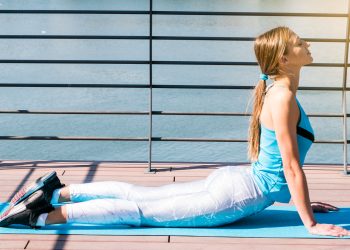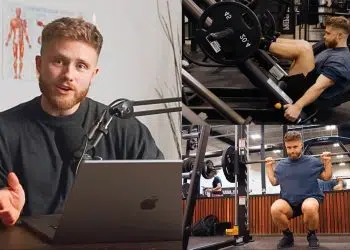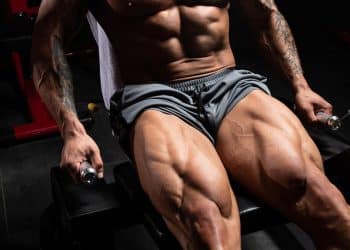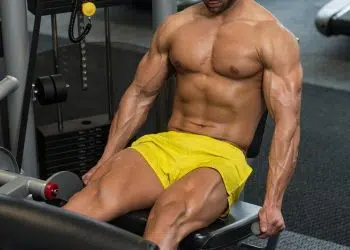Friends don’t let friends skip leg day, or so the popular meme says. Yet many people neglect their leg workouts and instead focus on muscles that are less taxing to train, like the chest and biceps.
Leg training is hard, as they make up, on average, 40% of your total body mass, and training them requires lots of energy. They also demand loads of oxygen, which is why training your legs can leave your heart pounding and lungs heaving.
However, building shapely and proportional legs is easier said than done. In my 35 years as a personal trainer, I have noticed many people struggle to develop the vastus lateralis (quad sweep), which is the most powerful quadriceps muscle.
In this article, I reveal the 11 best vastus lateralis strengthening and stretching exercises for building balanced and jacked wheels.
Recent Updates: On June 11, 2024, Fitness Volt’s Senior Editor, Vidur Saini (American Council on Exercise-CPT), updated the article and added actionable expert tips throughout the piece to improve the reader experience. Level Up Your Fitness: Join our 💪 strong community in Fitness Volt Newsletter. Get daily inspiration, expert-backed workouts, nutrition tips, the latest in strength sports, and the support you need to reach your goals. Subscribe for free!
11 Best Vastus Lateralis Strengthening and Stretching Exercises
Whether you want to build more muscular thighs, run faster, jump higher, or improve knee mobility and stability, these are the best strengthening and stretching exercises to do it!
- Sissy Squat
- Front Squats
- Narrow Stance Leg Press
- Narrow Stance Goblet Squats
- Narrow Stance Hack Squats
- Lunges
- Bulgarian Split Squat
- Prone Quads Stretch
- Standing Quads Stretch
- Kneeling Quads Stretch
- Foam Rolling The Quadriceps
1. Sissy squat
| Sets & Reps | Equipment Needed | Target Muscles |
| 3 x 8-12 | Sturdy Object for Support | Quadriceps, Rectus Femoris |
Don’t let the name fool you, sissy squats are anything but easy. Even if you just use your body weight, this exercise will hammer your quads, especially that all-important vastus lateralis.
Do this exercise at the start of your leg workouts to pre-fatigue your quads or at the end to finish them off. Think of it as an all-natural leg extension movement.
How to do it:
- Stand next to a wall or some other object you can use for balance. Your feet should be no more than hip-width apart.
- Rise up onto your tiptoes.
- Push your hips and knees forward and squat down as you simultaneously lean back. Descend as far as you can, ideally until your calves and hamstrings touch.
- Drive your toes into the floor and stand back up.
- Tense your quads and glutes at the top of each rep and repeat.
- The more you lean back, the harder this exercise becomes.
Pro Tip: During the eccentric phase (lowering), actively resist the urge to collapse into the stretch reflex to increase the time under tension (TUT) and promote hypertrophy.
| Difficulty | Progression | Regression |
| Advanced | Weighted Sissy Squat (hold a weight plate or dumbbell) | Sissy Squat against a wall |
2. Front squats
| Sets & Reps | Equipment Needed | Target Muscles |
| 4 x 6-8 | Barbell, Squat Rack | Quadriceps, Hamstrings, Gluteus Maximus, Core |
While most lifters favor back squats, front squats bias the vastus lateralis. Front squats require better mobility in the upper and lower body, but that’s part of what makes them such an effective exercise. So, switch from back squats to front squats, and your quads will explode!
“Incorporating front squats into your training can significantly improve your thoracic spine mobility, leading to better posture and performance in other compound lifts,” says Saini.
How to do it:
- Put a barbell in your squat rack at about shoulder height.
- Walk forward and put your anterior (front) deltoids against the bar. Grip the bar with your hands just wider than shoulder-width apart.
- Push your elbows forward and under the bar so your upper arms are parallel to the floor. The bar should rest against your neck, but it should not press heavily on your throat.
- Brace your core and pull your shoulders down and back. Unrack the bar and step back.
- Set your feet about hip-width apart.
- Brace again, inhale, and bend your knees and hips simultaneously. Descend as far as you can while keeping your torso upright, your elbows up, and your knees in line with your toes. Do not allow your knees to drop out or fall in. Look straight ahead and not down.
- Without bouncing out of the bottom, drive your feet into the floor and stand back up. Force your elbows upward as you ascend to stop the bar from rolling off your shoulders.
- Rerack the bar and rest, or reset your core and repeat if you are doing multiple reps.
Pro Tip: Think about driving your elbows up as you ascend from the bottom of the squat to maintain an upright torso and prevent the hips from rising too quickly.
| Difficulty | Progression | Regression |
| Intermediate | Zercher Squat | Goblet Squat |
Read also: Front squat hypertrophy guide
3. Narrow stance leg press
| Sets & Reps | Equipment Needed | Target Muscles |
| 3 x 8-12 | Leg Press Machine | Quadriceps (Vastus Medialis emphasis), Gluteus Maximus |
If balance is an issue during front squats, you can make things easier by doing narrow stance leg presses. Using a close stance, i.e., hip width or less, increases vastus lateralis engagement.
Ensure you follow a full range of motion (ROM) for maximum quad stimulation. Go as low as your mobility allows and pause in the fully lengthened position for a second before pressing the weights.
How to do it:
- Place your feet inside shoulder-width on the footplate. Your toes should be pointing straight.
- Unhitch the sled and begin the descent by slowly flexing your knees.
- Go as low as possible and pause in the bottom position.
- Explode back to the starting position.
- Repeat for recommended reps.
Pro Tip: Most people cannot go as deep on this exercise as the shoulder-wide variation, so prioritize a slow rep tempo to maximize target muscle activation.
| Difficulty | Progression | Regression |
| Beginner | Increase weight or reps | Single Leg Press |
Read more about leg presses here.
4. Narrow stance goblet squats
| Sets & Reps | Equipment Needed | Target Muscles |
| 3 x 10-15 | Dumbbell or Kettlebell | Quadriceps, Gluteus Maximus, Adductors |
Narrow stance goblet squats are a useful alternative to front squats. Holding a single weight in front of your chest makes balancing much easier and requires far less upper-body mobility than using a barbell.
Saini recommends maintaining tension in your adductors during the descent by imagining you’re squeezing a block between your thighs.
How to do it:
- Stand with your feet about hip-width apart, toes pointing forward. Hold a kettlebell or dumbbell in front of your chest and just below your chin. Pull your shoulders down and back and brace your abs.
- Bend your legs, push your hips to the rear, and squat down until your thighs are at least parallel to the floor. Take care not to round your lower back.
- Stand back up and repeat.
Pro Tip: Goblet squats with a narrow stance are a fantastic way to introduce beginners to the squat pattern while emphasizing proper knee tracking and glute activation.
| Difficulty | Progression | Regression |
| Beginner | Increase weight, reps, or sets | Regular Stance Goblet Squat |
5. Narrow stance hack squats
| Sets & Reps | Equipment Needed | Target Muscles |
| 3 x 8-12 | Hack Squat Machine | Quadriceps (emphasis on Vastus Lateralis), Gluteus Maximus |
The hack squat machine provides a very targeted workout for your quads. With plenty of back support, you can focus on pushing your quads to their limit. Using a narrow stance increases vastus lateralis activation. However, all four quad muscles will be working hard during this exercise.
Saini urges slightly rotating your feet outwards (5-10 degrees) to bias the vastus lateralis (outer quad).
How to do it:
- Adjust the machine so that your shoulders are comfortably under the padding while standing on the platform.
- Stand with your feet about hip-width apart.
- Release the weight catchers and then slowly squat down so your upper legs are at or slightly below parallel.
- Squat back up through your heels into a standing position.
- Complete the desired number of reps and then rerack the weight.
Pro Tip: The hack squat machine provides a fixed line of pull, making it a valuable tool for isolating the quads and minimizing lower back strain.
| Difficulty | Progression | Regression |
| Intermediate | Increase weight or reps | Regular Stance Hack Squat |
6. Lunges
| Sets & Reps | Equipment Needed | Target Muscles |
| 3 x 8-12 (per leg) | Bodyweight, Optional Dumbbells | Quadriceps, Hamstrings, Gluteus Maximus |
Lunges are an excellent exercise for your entire lower body. However, because most of your weight is on your front leg, you’ll have to work extra hard to stop your knees from falling inward or outward, which increases vastus lateralis engagement.
You can do lunges with an external load or just your body weight for resistance. Forward, backward, and walking lunges are all great vastus lateralis exercises. You can also make them more challenging by raising your front foot, which increases the range of motion. These are called deficit lunges.
Level Up Your Fitness: Join our 💪 strong community in Fitness Volt Newsletter. Get daily inspiration, expert-backed workouts, nutrition tips, the latest in strength sports, and the support you need to reach your goals. Subscribe for free!
How to do it:
- Stand upright with a hip-width stance.
- Step forward with your left leg.
- Slowly bend your knees to lower yourself toward the floor, until the back knee gently touches the floor.
- Extend your knees to return to the starting position.
- Repeat on the other side.
Pro Tip: To increase core activation and improve stability, exhale forcefully at the bottom of the lunge and brace your core as if you’re about to be punched in the stomach.
| Difficulty | Progression | Regression |
| Beginner | Walking Lunges | Static Lunges |
Read all about lunges in our detailed guide.
7. Bulgarian split squat
| Sets & Reps | Equipment Needed | Target Muscles |
| 3 x 8-12 (per leg) | Bench or Elevated Platform, Optional Dumbbells | Quadriceps, Hamstrings, Gluteus Maximus |
Bulgarian split squats are an advanced variation of lunges. Like lunges, you must use your vastus lateralis to stabilize your front knee. Bulgarian split squats make balancing a little harder and put more weight on your front leg, making them even more effective for vastus lateralis development. Do them with or without weight as required.
“Lean slightly forward from the hips as you descend to bias the quads and help prevent the back knee from hitting the floor too early,” suggests Saini.
How to do it:
- Stand with your back to a knee-high exercise bench. Bend one leg and place the top of your foot on the bench behind you. Hop forward and into a split stance.
- Bend your legs and lower your rear knee down toward the floor. Keep your lower back straight and your chest and head up. Try to keep your front shin close to vertical, and do not let your knee move beyond your toes.
- Push down through your front leg and stand back up. You should feel that about 70% of your weight is on your front leg, and about 30% is on your rear leg.
- Do the same number of reps on each leg.
Pro Tip: Tight quads can affect your knees and make them more prone to injury. Maintain or improve your quadriceps flexibility with these stretches, all of which involve the vastus lateralis.
| Difficulty | Progression | Regression |
| Intermediate | Increase the height of the back foot elevation | Static Lunges |
8. Prone quads stretch
| Sets & Reps | Equipment Needed | Target Muscles |
| Hold for 30 seconds, 3 repetitions | Yoga Mat or Soft Surface | Quadriceps |
This is arguably the most relaxing way to stretch your quads. As an added advantage, lying on your front ensures that you keep your thighs together and cannot over-extend your hips. As such, this is a very joint-friendly way to stretch those hard-worked quads, especially the three vastus muscles.
How to do it:
- Lie on your front with your legs straight and thighs together. Rest your head on one arm.
- Bend one leg and reach back to grasp the top of your foot near your ankle joint. If that is too challenging, you can loop a towel or yoga strap around your foot.
- Gently pull your foot in toward your butt. Do not force the movement but do pull in to a point where you feel tension in the front of your thigh.
- Hold for 20-60 seconds and then relax and switch sides.
Pro Tip: Contract your glutes while holding the stretch. This reciprocal inhibition technique will help relax the quadriceps and allow for a deeper stretch.
| Difficulty | Progression | Regression |
| Beginner | Increase hold time or repetitions | Assisted Prone Quads Stretch (use a strap or towel to gently pull the heel towards the glute) |
9. Standing quads stretch
| Sets & Reps | Equipment Needed | Target Muscles |
| Hold for 30 seconds, 3 repetitions | None | Quadriceps, Hip Flexors |
This exercise is ideal for those times when you don’t want to spend a long time stretching. It’s performed standing, so you can do it almost anywhere and anytime. As such, this exercise is perfect for warm-ups, cool-downs, and doing between sets of strength training.
The standing quad stretch is a simple yet effective way to improve hip flexor flexibility, which can benefit individuals who spend a lot of time sitting.
How to do it:
- Stand with your feet together, arms by your sides, and shift your weight onto one leg.
- Bend your unloaded leg and bring your foot up toward your butt. Reach back with your arm, grab the top of your ankle, and gently pull your foot toward your butt to deepen the stretch. Push your hips forward for an even more intense stretch.
- If you lose your balance, feel free to use your non-working arm for stability. For example, you can hold the back of a chair, wall, or doorframe if needed.
- Hold for 20-30 seconds and then relax and switch sides.
Pro Tip: Engage your core to prevent excessive arching of the lower back.
| Difficulty | Progression | Regression |
| Beginner | Increase hold time or repetitions | Assisted Standing Quads Stretch (use a wall or chair for balance) |
10. Kneeling quads stretch
| Sets & Reps | Equipment Needed | Target Muscles |
| Hold for 30 seconds, 3 repetitions | Yoga Mat or Soft Surface | Quadriceps, Hip Flexors |
The kneeling quads stretch extends your hip, which lengthens the rectus femoris muscle. Like all the hip flexors, the rectus femoris is often tight, which may make this exercise harder than the other quads stretches in this article. Still, if you find this stretch difficult, that’s a good sign you need to do it more often!
Saini says the kneeling quad stretch is a gentle variation that can be used by beginners or those with limited flexibility. It can also help improve balance and stability.
How to do it:
- Kneel down on a folded exercise mat for comfort. Place one leg out in front of you with your foot flat on the floor and your knee bent to around 90 degrees.
- Bend your rear leg and reach back to grab your ankle. Gently pull your heel in toward your butt. Do not force the movement but do pull in to a point where you feel tension in the front of your thigh.
- Hold for 20-60 seconds and then relax and switch sides.
Pro Tip: Tuck your pelvis under to increase the stretch in the hip flexors, improve overall hip mobility, and reduce tension in the front of the hip.
| Difficulty | Progression | Regression |
| Beginner | Increase hold time or repetitions | Assisted Kneeling Quads Stretch (use a wall or chair for balance) |
11. Foam rolling the quadriceps
| Sets & Reps | Equipment Needed | Target Muscles |
| Roll for 1-2 minutes | Foam Roller | Quadriceps |
Your muscles are surrounded by a thin layer of fibrous tissue called fascia. Fascia separates and connects each muscle from its neighbor. This fascia can become “gummed up,” leading to tight, painful muscles. This can cause trigger points, poor blood flow, and reduced function.
Foam rolling is a form of self-myofascial release that can help free up your fascia and restore normal movement and function. Foam rolling your quads will enhance knee and hip joint mobility and performance.
“Foam rolling the quads can help improve blood flow and reduce muscle tightness, leading to improved performance and reduced risk of injury,” Saini says.
How to do it:
- Lie on your front on your foam roller. The roller should be under your thighs. Shift your weight across so that you are emphasizing one leg at a time. Bend the knee you on the leg you want to work on.
- Roll back and forth along your thigh. Turn your leg in and out to hit all sides of your quads.
- Seek out any areas of tightness and spend a little longer working on them until they start to diminish.
- Increase the pressure by crossing your other leg over the one you’re treating.
- Continue for 2-4 minutes, and then swap sides.
Pro Tip: Foam rolling can be painful. But, as the adhesions start to dissolve, subsequent foam rolling sessions should be less uncomfortable. Increase the pressure gradually to avoid unnecessary pain.
| Difficulty | Progression | Regression |
| Beginner | Roll for a longer duration or use a firmer foam roller | Roll over a softer surface or use a tennis ball for more targeted pressure |
Best Quad Workout
Add the following workout to your regime to build jacked thighs:
| Exercise | Sets | Reps | Rest (seconds) |
| Front Squats | 4 | 6-8 | 90-120 |
| Narrow Stance Leg Press | 3 | 8-12 | 60-90 |
| Bulgarian Split Squat | 3 | 8-12 (per leg) | 60-90 |
| Narrow Stance Goblet Squat | 3 | 10-15 | 60 |
| Sissy Squat | 3 | 8-12 | 60 |
Quadriceps Anatomy 101
Great-looking legs start with well-developed quads. Sure, the hamstrings and glutes are important, and so too are the calves, but it’s those beefy quads that really stand out. The quadriceps are so called because they’re made up of four muscles. Each has a unique origin point and then comes together at a shared insertion point just above your patella or knee cap.
The four quadriceps are:
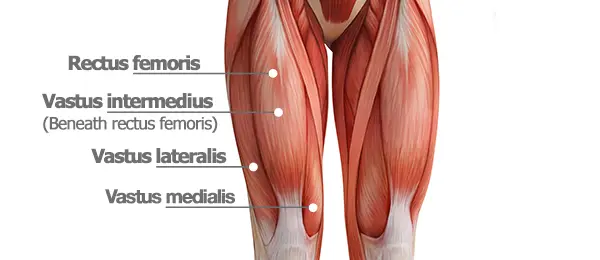
Rectus femoris
The rectus femoris is the longest of the quadriceps muscles. It’s also biaxial, meaning it crosses two joints. As such, the rectus femoris has two primary functions: knee extension and hip flexion.
Vastus medialis
Where rectus femoris is the longest quadriceps muscle, vastus medialis is the shortest. This muscle is just above your knee and shaped like a teardrop. It’s responsible for straightening the knee and is most active in the last few degrees of extension. The vastus medialis plays a role in knee stability and helps prevent unwanted lateral movements.
Vastus intermedius
Located between vastus medialis and vastus lateralis, this long muscle really stands out at the front of your thighs. It’s a very powerful knee extensor and makes up a lot of the bulk of your anterior thighs.
Vastus lateralis
The vastus lateralis is the largest, strongest muscle in the quadriceps group. It’s located on the side of your thigh and gives your quads their width. Well-developed vastus lateralis gives your thighs a pleasing shape, which is often called the quad sweep.
Besides being a knee extensor, the vastus lateralis also plays a vital role in knee joint stability, especially during walking, running, and other unilateral or single-legged exercises.
It’s important to understand that the quadriceps always work together, and it is impossible to isolate any of the four muscles. That said, it is possible to emphasize each one by using specific movements. However, all four quads will be involved in whatever exercises you do for your anterior thighs.
Wrapping Up
Training the quads is almost always hard and usually painful. They’re big muscles that demand a lot of energy, and virtually any quad exercise you do will leave you feeling out of breath and your muscles burning.
However, leg training is also very satisfying, and you’ll leave the gym knowing you’ve just done something that a lot of lifters are not prepared to do. That’s why some people are reticent about wearing shorts — they’re embarrassed of their skinny legs!
So, no more skipping leg day. Use these exercises to strengthen and stretch that all-important vastus lateralis muscle for a more impressive quad sweep.


